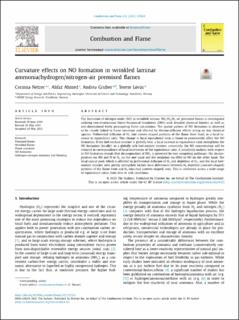| dc.contributor.author | Netzer, Corinna | |
| dc.contributor.author | Ahmed, Ahfaz | |
| dc.contributor.author | Gruber, Andrea | |
| dc.contributor.author | Løvås, Terese | |
| dc.date.accessioned | 2021-07-13T07:42:03Z | |
| dc.date.available | 2021-07-13T07:42:03Z | |
| dc.date.created | 2021-07-12T14:35:44Z | |
| dc.date.issued | 2021 | |
| dc.identifier.citation | Combustion and Flame. 2021, 232, . | en_US |
| dc.identifier.issn | 0010-2180 | |
| dc.identifier.uri | https://hdl.handle.net/11250/2764225 | |
| dc.description.abstract | The formation of nitrogen oxide (NO) in wrinkled laminar NH3/H2/N2-air premixed flames is investigated utilizing two-dimensional Direct Numerical Simulation (DNS) with detailed chemical kinetics as well as one-dimensional freely propagating flame calculations. The spatial pattern of NO formation is observed to be closely linked to flame curvature and affected by thermo-diffusive effects acting on key chemical species. Preferential diffusion of H2 into convex-shaped portions of the flame front leads to a local increase in equivalence ratio. This change in local equivalence ratio is found to prominently affect the NO formation. If the fuel-oxidant mixture is globally lean, a local increase in equivalence ratio strengthens the NO formation (locally); in a globally rich fuel-oxidant mixture, conversely, the NO concentration will be reduced in correspondence of local increments of the equivalence ratio. A sensitivity analysis with respect to NO formation reveals that decomposition of NH2 is governed by two competing pathways: the decomposition via NH and N to N2 on the one hand and the oxidation via HNO to NO on the other hand. The local radical pool, which is affected by preferential diffusion of H2 and depletion of O2, and the local fuel-oxidant mixture ratio jointly strengthen further local differences between H2-depleted (concave-shaped) portions of the flame front and H2-enriched (convex-shaped) ones. This is confirmed across a wide range of equivalence ratios from lean to rich conditions. © 2021 The Authors | en_US |
| dc.language.iso | eng | en_US |
| dc.publisher | Published by Elsevier Inc. on behalf of The Combustion Institute | en_US |
| dc.rights | Navngivelse 4.0 Internasjonal | * |
| dc.rights.uri | http://creativecommons.org/licenses/by/4.0/deed.no | * |
| dc.title | Curvature effects on NO formation in wrinkled laminar ammonia/hydrogen/nitrogen-air premixed flames | en_US |
| dc.type | Peer reviewed | en_US |
| dc.type | Journal article | en_US |
| dc.description.version | publishedVersion | en_US |
| dc.source.volume | 232 | en_US |
| dc.source.journal | Combustion and Flame | en_US |
| dc.identifier.doi | 10.1016/j.combustflame.2021.111520 | |
| dc.identifier.cristin | 1921515 | |
| dc.relation.project | Notur/NorStore: nn9527k | en_US |
| dc.relation.project | Norges forskningsråd: 617137 | en_US |
| dc.description.localcode | © 2021The Authors. This is an open access article under the CC BY license (http://creativecommons.org/licenses/by/4.0/) | en_US |
| dc.source.articlenumber | 111520 | en_US |
| cristin.ispublished | true | |
| cristin.fulltext | original | |
| cristin.qualitycode | 2 | |

